You are here:
PacLII >> Databases >> Niue Department of Justice and Courts Annual Reports
>> Niue High Court Land Division 2012-2013 Annual Report
Niue High Court Land Division - 2012-2013 Annual
Report
Download PDF version [457KB]
NIUE HIGH COURT - LAND DIVISION
Annual Report
July 2012 - June 2013
Tiara Taso Tukuniu
Court Administrator Officer
GOVERNMENT OF NIUE/ Department of Justice, Lands
& Survey/POBox75/
Alofi/
NIUE/ Telephone (683) 4127/ Facsimile (683) 4231
Content
Mission and Vision
MISSION
VISION
Message from Chief Justice
Overview of the Judiciary of the High Court of Niue
About the Courts
Organizational Chart
Niue High Court- Land Division
Court Personnel – (Land Division)
Niue Court of Appeal
Indicator 1 – Case Management – Clearance Rate
Indicator 2 – Case Management – Average Duration of
a Case
Indicator 3 - Case Management – Percentage of
Appeals
Indicator 4 – Case Management – Overturn Rate on
Appeal
Indicator 5 – Accessibility of Courts – Court Fee
Waiver
Indicator 6 – Accessibility of Courts – Circuit
Courts
Indicator 7 – Accessibility of Courts – Legal Aid
Indicator 8 – Complaint Handling and feedback policy
Complaint Process
Indicator 9 – Complaint Handling and feedback –
Judicial Officers
Indicator 10 – Complaint Handling and feedback –
Court Staff
Indicator 11 – Judicial Resources
Indicator 12 – Court Staff Resources
Indicator 13 – Transparency – Annual Report
The 2011/2012 Annual Department Budget
Figure 1: Clearance
Rate.
. 15Figure 2: Clearance Rate Trend
Figure 3: Average Duration of a Case
Figure 4: Percentage of Appeals
Figure 5: Overturn Rate on Appeal
Figure 6: Complaint Process for Public Servants
in
Niue
Figure 7: Average number of cases per judicial
officer
Figure
8: Average number of cases per court
administrator officer
Introduction
Mission and Vision
MISSION
To
be an independent body that is responsible for interpreting and applying the
laws made by the Assembly of Niue. Develops and interprets case law and
resolves disputes of fact and law between individuals and between individuals
and the state.
VISION
To be neutral, well-managed, and respected, reflecting
not only the importance of the work we do but also to guarantee that the
independence of the Court is maintained and it follows the confidence of the
public in the Court system.
Message from Chief Justice
This
report describes the work of the Land Division of the Niue High Court from July
2012 to June 2013.
In
August last year I commented quite fully on the administration of justice in
Niue when the previous report was published.
I do not want to go over the points that I made then at any length,
because they remain just as relevant now.
In
all Polynesian societies land and family relationships are closely linked and
are major elements in the way society is structured and functions. It is therefore critical for freedom,
security and orderly development that land issues in Niue are dealt with
promptly and in accordance with the rule of law. The rule of law should never be taken for
granted. It has an inherent fragility in
societies under stress as we see in events all around the world. It must be cherished and nourished. Niue has an inherently stable legal system
and the rule of law is respected.
In
my previous report I referred to the work done by local members of the
judiciary in Niue, the Court staff and legal volunteers from New Zealand. All of these people give tirelessly and
ensure that the legal system runs as it should.
I want again to thank those who give so much in this regard.
The
High Court continues to sit twice a year and all of the Judges now, are members
of the New Zealand Māori Land Court. We
have a new Judge, Judge Sarah Reeves, who I know is looking forward to coming
to Niue and working with you.
I
want finally to congratulate those who have compiled this report. It is an important publication in that it
communicates with the people of Niue and advises them of the work done by the
Land Division of the High Court of Niue.
P J
Savage
CHIEF JUSTICE
Overview of the Judiciary of the High Court of
Niue
The
bench of the High Court of Niue consists of Judge Wilson W. Isaac, Judge Craig
T Coxhead and Chief Justice Patrick
Savage. The recent passing of Judge Norman Smith Wednesday 24th July
2011 has created a vacancy on the bench that was filled by Judge Sarah Reeves who
was officially sworn in on 28 March 2014 in Wellington.
All
High Court Judges are based in New Zealand and most often circuit to the Niue
High Court every six months. The Court of Appeal may be convened either in Niue
or New Zealand depending on the matters before that court.
The
High Court Land Commissioners was newly appointed on the 30th
January 2014 are Mrs. Rheumatic Alapaki, Mrs. Rubina Morrisey, Mrs. Maihetoe
Hekau, Ms. Lilivika Liumaihetau, Mrs. Taumalua Jackson, Mr. Robin Hekau, Mr. Saukia
Tukuitonga and Mr. Hale Ikitule.
The
Niue based judicial officers have established their own association i.e. the
Niue Judicial Association, which provides the judiciary with the opportunity to
meet and discuss issues that are relevant to the administration of the law. The
Department endeavors to assist the association in its aims to strengthen the
capacity of the local judicial officers by attending the meetings of the
association and giving advice and clarification to any questions or concerns
raised by the members of the association.
Other
capacity building assistance is provided to the Judiciary through the Pacific
Judicial Development Program and the Maori Land Court.
About the Courts
LAND TITLING AND LAND REGISTRATION
PROCESS FLOW CHART
FINAL PLAN & REGISTRATIONS OF TITLE
Organizational Chart
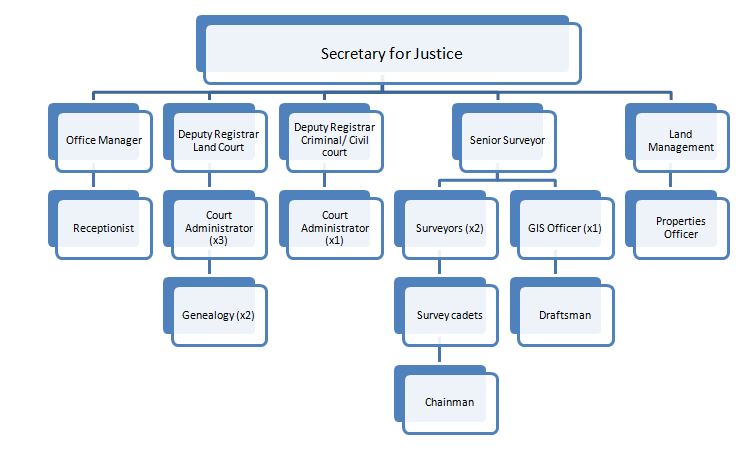
Niue High Court - Land Division
The
Niue High Court is presided over by the Chief Justice and held twice a year
with one of the four judges sitting. From July 2012 to June 2013, two High
Court sittings were conducted. A special sitting was arranged for the Criminal
Division to be held from the 16th to 20th July 2012, unfortunately, did not
proceed as schedule. The High Court Land division did proceed with a list of 27
cases of which 17 cases were finalized and 12 cases adjourned to a future court
sitting.
The
High Court Sitting for November 2012 was cancelled due to health concerns
related to an outbreak of dengue fever on the island. In March 2013, two Judges
over a 5 day sitting each listed a total of 233 cases for hearing. Of these 233
cases, a total of 106 cases were finalized, 9 cases were dismissed and the 120
adjourned to a future sitting.
Court Personnel – (Land Division)
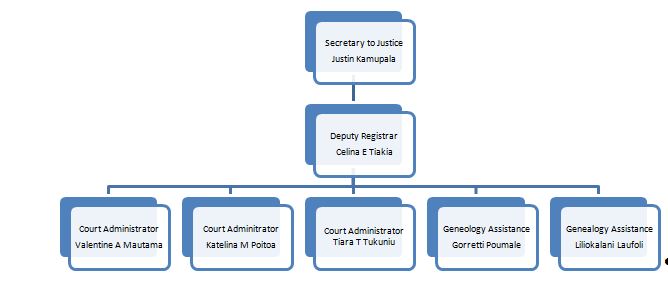
Niue Court of Appeal
The
Niue Court of Appeal is held approximately every 3 years. The last Court sitting
was held in March 2012 by Chief Justice Patrick Savage, Justice Craig T
Coxhead, Justice Norman Smith and Justice Wilson W Isaac for cases where the
latter’s decision was not the subject of appeal. The next Niue Court of Appeal
sitting should be scheduled in 2015, depending on budget issues and the
confirmation of the election date. Once
these are confirmed the Niue Court of Appeal sitting dates will be noted and
funding included in the 2014/2015 budget.
The
Cook Islands Indicators
Indicator 1 – Case Management – Clearance Rate
Figure
1 below shows that there were 209 cases filed in the Land Division of the Niue
High Court during the 2012-13 financial years. Of these 209 cases, 96 cases
were finalized leaving a pending list of 425 cases (this does not include cases
pending prior to 2008).
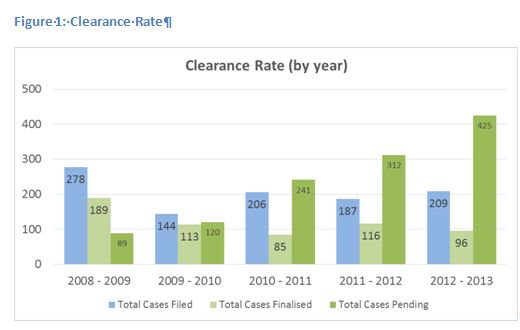
The
clearance rate indicates that the Land Division of the Niue High Court is
currently receiving more applications than they are disposing of, meaning that
there is more work coming in than going out. This trend is highlighted in
Figure 2 below.
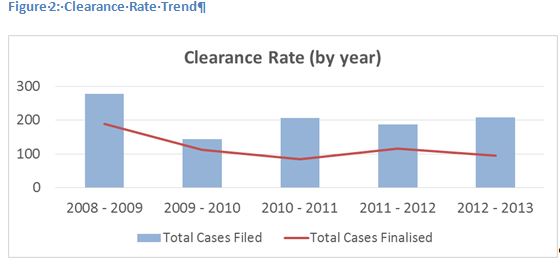
There
are various reasons why the disposal rate is low for cases in the Land Court. For
example, the majority of applications filed within the office are Niuean
citizens living overseas. This means that it is often easy for them to file an
application but difficult for them to process the application as some families
support it and some do not as some families do not want to get involved in land
disputes. Many of these applications therefore remain open. The Court issues reminder
letters and emails to each applicant and in most cases the Court is advised to
leave the application pending as they will proceed with the application at the
next court sitting. Often at the next court sitting parties seek an adjournment
or they agree to withdraw their application.
The
number of pending cases is also affected by the fact that the Land
Division of the Niue High Court has reestablished its Land
Commissioners but they have yet to conduct a hearing and is reliant
upon Judges from New Zealand to travel to Niue to conduct hearings
twice a year.
Indicator 2 – Case Management – Average Duration
of a Case
The
average duration of a case shows how long each case takes on average to finalize
in the Land Division of the Niue High Court. Figure 3 below indicates that the
average time a case spends in the system is reducing. It currently takes on
average 140 days, a drop from 289 in 2008-09. The Land Division of the Niue
High Court does not have a current time standard for the average duration of a
case.
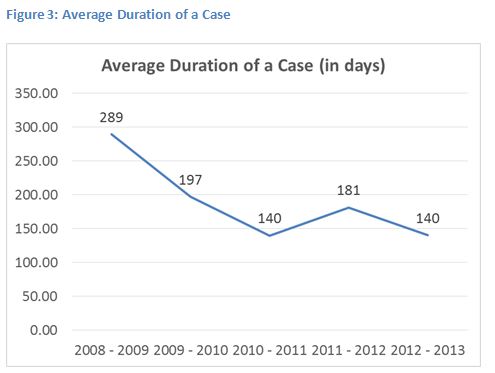
Indicator 3 - Case Management – Percentage of Appeals
The
current rate of appeal in the Land Division of the Niue High Court is five per
cent, for instance, for every 100 decisions, five decisions are appealed. Figure
4 below shows the trend in relation to appeals in the Land Courts.
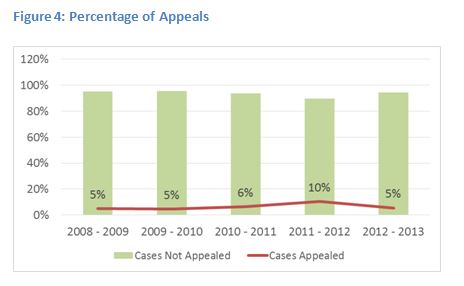
Indicator 4 – Case Management – Overturn Rate on
Appeal
Of
the five cases appealed in the 2012-13 financial year, only two were successful
whereby the original decision was overturned and a new decision was ordered see
below.
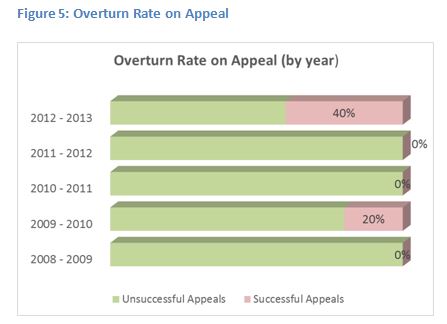
Indicator 5 – Accessibility of Courts – Court
Fee Waiver
The
Land Division of the Niue High Court does not currently have a formal Court Fee
Waiver policy to meet the needs of those who are unable to pay for the cost of
filing. The Land Court did however waive the costs of two applications in
2010-11 because the applicant family was faced with unforeseen circumstances
and were unable to pay the costs associated with filing the application.
Indicator 6 – Accessibility of Courts – Circuit
Courts
The
Land Division of the Niue High Court does not conduct circuit courts. All
applications and court sittings take place at the Government Building
conference room. On occasion, a hall may be hired if the government building is
already in use.
Indicator 7 – Accessibility of Courts – Legal
Aid
Niue
does not have a specific legal aid program however there are presently three
volunteers from the New Zealand legal profession who assist litigants in this Court.
Indicator 8 – Complaint Handling and feedback
policy
The
complaint handling process is applied to public servants working in the Niue
Land Court. Judicial Officers are not subject to this process. The process
applied in relation to complaints regarding public servants can be seen in the detailed
process below in figure 7.
Complaint Process
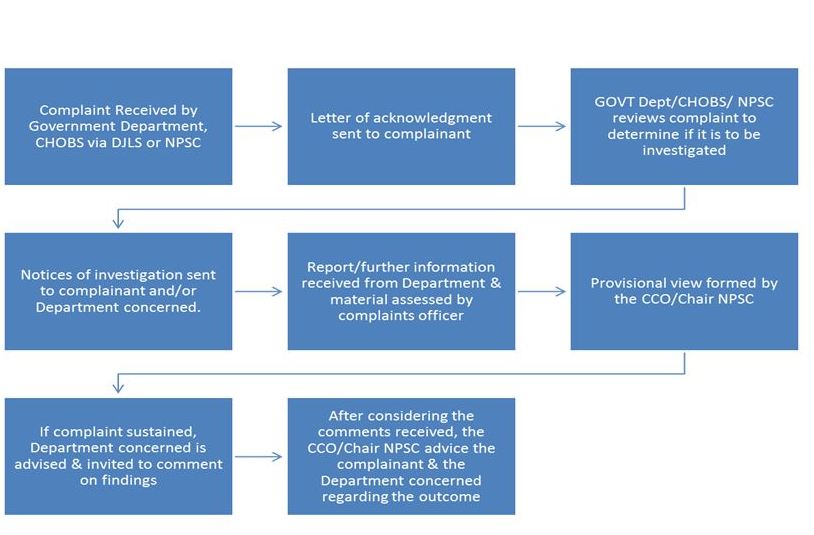
Indicator 9 – Complaint Handling and feedback – Judicial
Officers
No
complaints were received regarding judicial officers of the Niue Land courts
this financial year.
The
department of Justice also received complaints from the General Public –
regarding the changes of the Court Sitting Dates.
Indicator 10 – Complaint Handling and feedback –
Court Staff
Three
complaints were received by the Registrar regarding staff of the Niue Land
Courts this represents less than 1.5 per cent of total filing in the Niue Land
Courts.
Indicator 11 – Judicial Resources
There
are presently four Judges in the High Court of Niue consisting of Judge Wilson
W. Isaac, Judge Craig T. Coxhead, and Judge Sarah Reeves. The current Chief
Justice is the Honorable Patrick Savage.
All are Judges of the Māori Land Court of New Zealand and have
experience in the area of Polynesian land issues. The chart below indicates that in the 2012-13
financial year, the average number of cases per judge was 70 cases, and
increase on previous years.
It
is critical that the Niue High Court maintains four Judges in order to ensure
that there are three judges to hear appeals from a decision of the fourth judge.
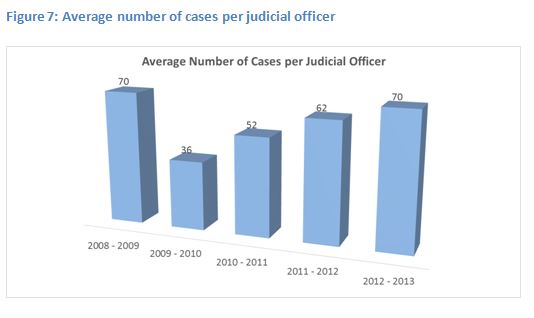
Indicator 12 – Court Staff Resources
In
year 2012-2013, 209 new applications were filed in the Niue Land Court. During
the financial year, there were 4 court administration officers tasked with
processing these applications which equates to a total of 52 applications per
staff member.
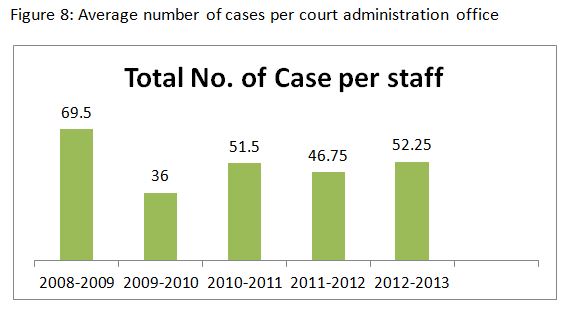
Indicator 13 – Transparency – Annual Report
The
Niue Land Court’s annual report is contained within the Departmental of Justice,
Lands and Survey annual report. The public may request a copy of the Department’s
annual report after it has been approved by Cabinet. The Department’s annual report
is also publically available on the PacLII website. Additionally, all information regarding the
services of the court is publicly available at the Department of Justice, Lands
and Survey.
The 2011/2012 Annual Department Budget
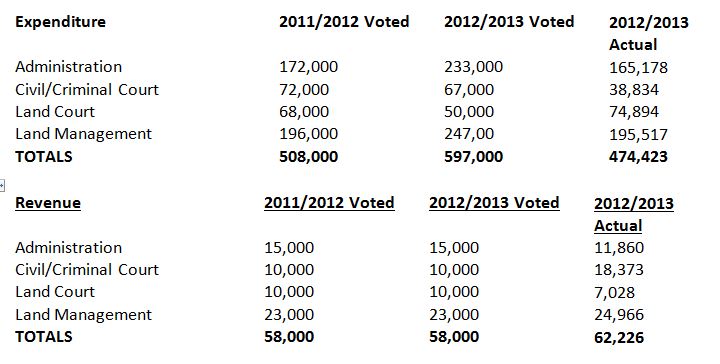
PacLII: Copyright
Policy | Disclaimers
| Privacy
Policy | Feedback|
Report
an error
URL: http://www.paclii.org/nu/court-annual-reports/2012-2013-hcldar.html

